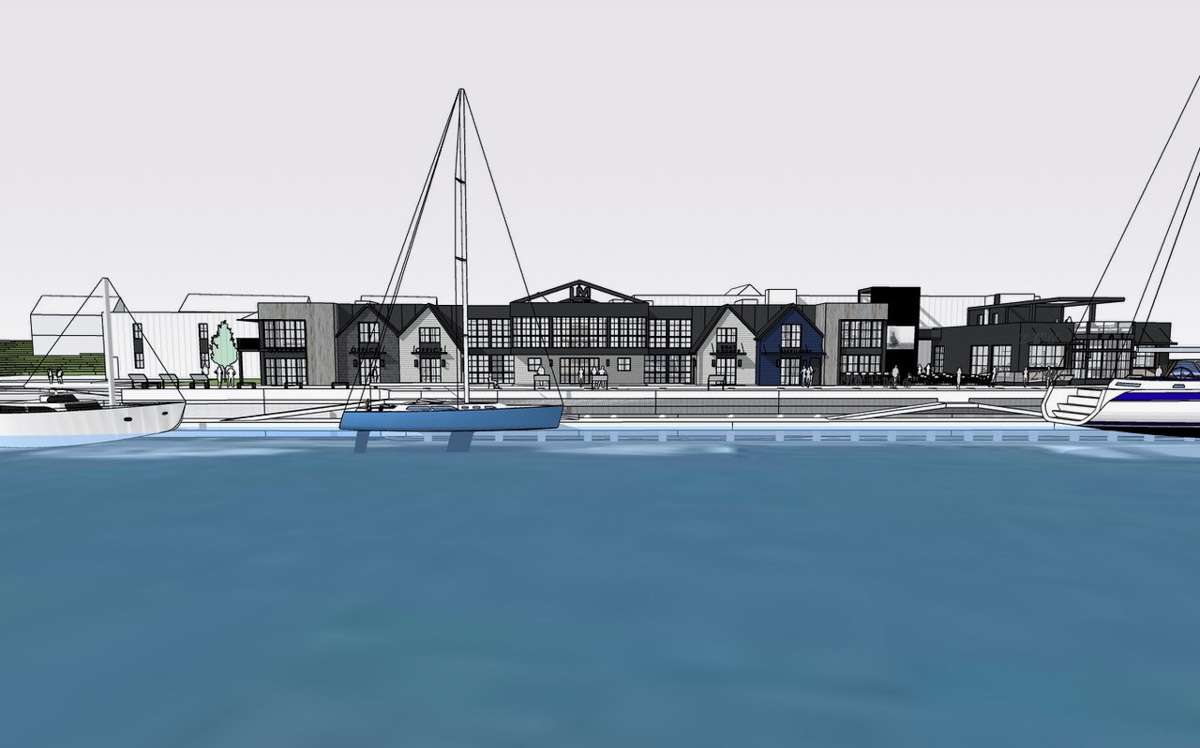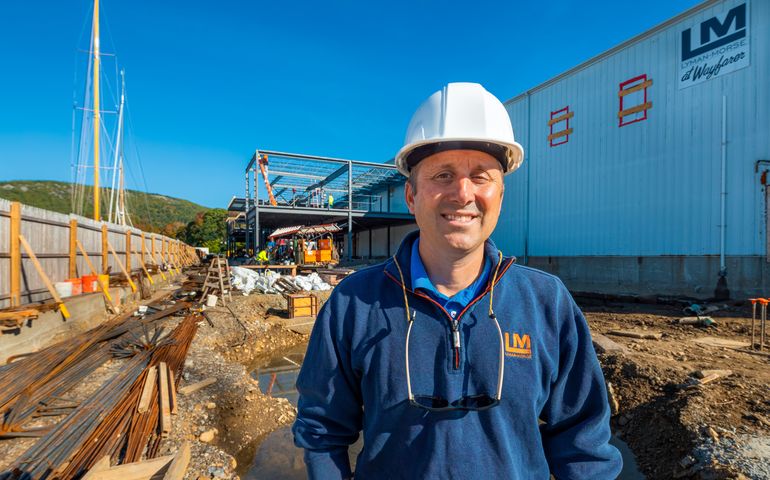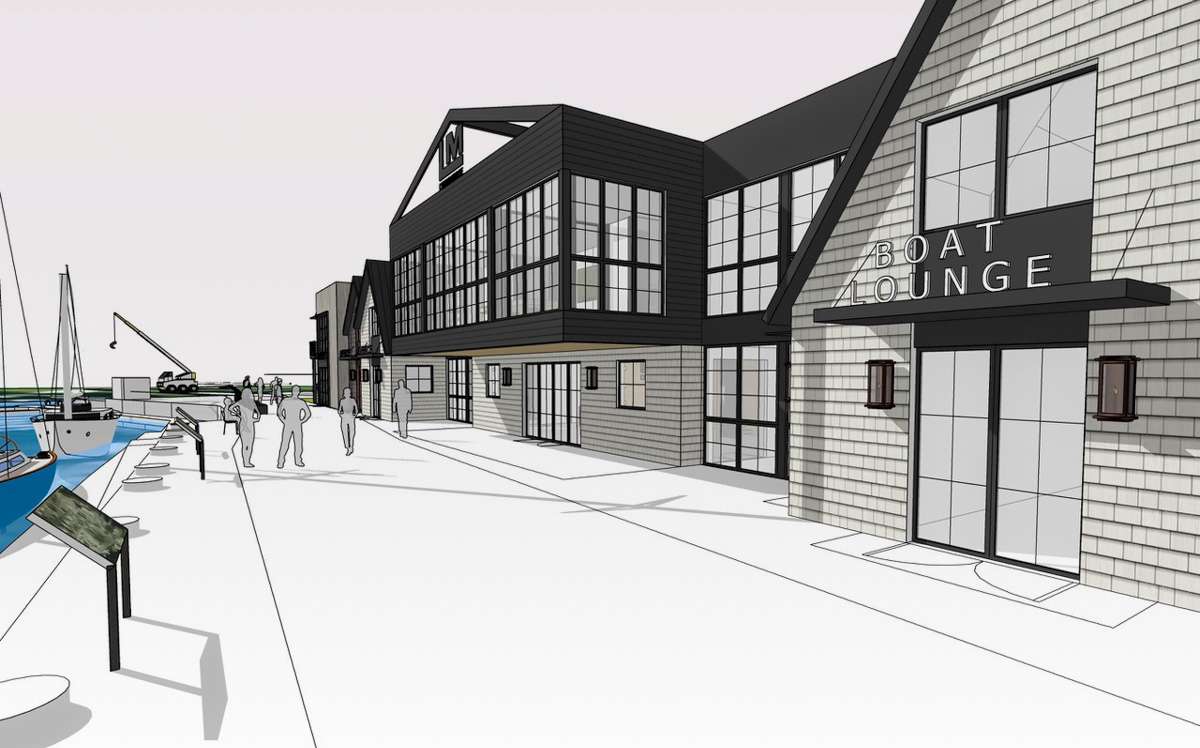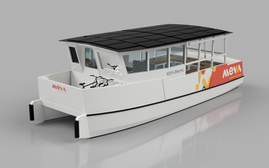
Harbor horizons: New waterfront investment seeks to enhance Camden’s power of attraction
 Photo / David Clough
Lyman-Morse’s president Drew Lyman, center, says a 2020 fire at the company’s Camden facility was an opportunity to move forward with a $15 million improvement project to build modern working waterfront infrastructure.
Photo / David Clough
Lyman-Morse’s president Drew Lyman, center, says a 2020 fire at the company’s Camden facility was an opportunity to move forward with a $15 million improvement project to build modern working waterfront infrastructure.
On any given summer day, Lyman-Morse’s Camden operation is a hive of activity.
Boaters from around the world and surrounding communities come and go from the marina’s docks and moorings, perhaps taking trips into town to enjoy local restaurants or buy provisions for their travels. Employees are busy providing repairs and refits, sail and metal fabrication, engine fixes and launch services.
An on-site restaurant and distillery attract boaters and local residents. Visitors are welcome to view the yard’s working waterfront activities. The company’s annual sailboat race joins other races, boating programs and historic passenger vessels to keep Camden Harbor a lively sight.
This year, the boatyard has been even busier with a $15 million improvement project, financed through Bangor Savings Bank, that includes reconstruction of an 11,000-square-foot facility, teardown of a hodgepodge of old buildings totaling 31,400 square feet and new construction of a 33,000-square-foot marine service complex.
“I want it to be open and inviting to the community and to visitors,” says Lyman-Morse’s president, Drew Lyman. “That’s the whole goal.”
The project benefits the broader community in many ways, says Camden’s planning and development director, Jeremy Martin.
“Lyman-Morse is one of the largest employers in town,” says Martin. “There are a lot of spinoff businesses that benefit from Lyman-Morse being here. I see this as an extension of our existing waterfront and our downtown.”

Boatyard fire
The yard, on the east shore of Camden Harbor, was formerly known as Wayfarer Marine. Large cargo schooners, World War II boats and yachts have been built here since the 19th century.
Lyman-Morse Boatbuilding, a Thomaston yacht builder that also offers technology and fabrication services, bought the yard in 2015 to expand its presence on the midcoast and give it a foothold in the busy harbor. It upgraded infrastructure, added services and increased the employee base to more than 50 today.
But a fire on a June night in 2020 caused extensive smoke damage throughout the yard’s main facility along the yard’s waterfront acreage.
Lyman views the situation as an opportunity to build “a 21st-century example” of modern working waterfront infrastructure designed to serve both the customer base and the local community.
Accelerated plans
The Camden campus is dominated by a 3.8-acre Inner Harbor Boatyard parcel that lines the shore and is easily visible to passersby. A short walk up a hill leads to additional acreage and buildings, where every square inch is used to store scores of boats in the winter. Along the shore, marine infrastructure includes docks and moorings used by many hundreds of transient boaters each year.
The fire occurred in the Inner Harbor Boatyard’s primary facility, adjacent to a 11,000-square-foot structure called Building 1.
There was burn damage where the fire originated, in a restaurant at one end of the building. More serious was the smoke damage.
“The smoke carried throughout the whole complex,” says Joshua Moore, the company’s special projects director.
So the company accelerated plans for a major upgrade of the Inner Harbor Boatyard. The project was due to occur at some point anyway, says Lyman, in order to replace a hodgepodge of vintage buildings with modern facilities designed with energy-efficiency, workforce-efficiency, and customer and community amenities in mind.
The project began right after the fire, when Building 1, which had been used for boat storage and service, was gutted and rebuilt with new sheathing, insulation, roofing, paint, heat and light systems, windows and the like.
All buildings around it were demolished. A new service building was designed to connect with Building 1 and will house purpose-built rigging, mechanics, electronics and carpentry workshops. Amenities will include radiant floor heat and an extensive rack system to store masts, booms and other rigging components. The spaces connect from one to the next, providing efficient workflow.
Running parallel to those storage and service buildings is a new structure that runs along the shore. This summer, Lyman-Morse’s construction manager, Lajoie Bros. of Augusta, performed sitework and installed foundations and utility lines for the building. Going up now are walls, roof and other structural elements, with expected completion by summer 2022.
The south end of the building will house a restaurant, distillery and courtyard. Progressing north, customer-oriented spaces will include a customer lounge with amenities such as a sitting area, showers and offices for yacht crews.
Then there are Lyman-Morse offices, including a reception area, stockroom, ship’s store and service manager’s offices.
Centralized access to service managers is intentional.
“When we bought this yard in 2015, we knew that the old buildings were hampering workforce productivity,” Lyman says. “We are gaining efficiency, both in terms of heating/insulation and creating a better working environment for our crew.”
Office rental spaces will also be available.

Sea level rise
The project includes new protections to waterfront infrastructure as storms become more frequent and violent. That includes raising all buildings above the flood plain and installing a new concrete retaining wall to replace a failing wooden one.
“That’s something we want to pay attention to,” says Lyman.
Marine infrastructure
The company is also looking to eventually expand its system of docks and piers to accommodate a growing clientele. That includes the possibility of installing a “wave attenuating” dock along the shore of the outer harbor. Wave attenuators are floating breakwaters that help dampen wave impacts as they approach the shore.
To that end, the company, partnering with the Maine Department of Transportation, received a $1.5 million federal grant in 2019 through the U.S. Fish and Wildlife Service’s Boating Infrastructure Grant program.
It will likely be several years before this part of the plan is finalized, as the company works through a slew of permits at the local, state and federal levels, Moore says.
Town improvements
The town of Camden also has improvement projects in the pipeline for properties it owns elsewhere along the harbor’s curving shoreline.
Following a state-funded Penobscot Bay working waterfront resilience analysis completed in 2019, Camden is now working on preliminary plans and looking at possible funding sources to ensure the town-owned public landing is resilient to sea level rise — a project that has a preliminary estimate of about $2.6 million, says Martin. The landing is a busy summer attraction surrounded by restaurants, shops and tour boats just a short walk from Camden’s downtown.
Challenges include insufficient elevation of shorefront structures in the face of tidal and storm surge.
“It’s a big project,” Martin says.
Like Lyman, Martin views challenges as opportunities to improve old infrastructure. That includes construction of an elevated harbormaster building, relocation of wharf utilities to secure them against floods and moisture infiltration, and new docks and pilings.
Also recommended in the analysis is reconstruction of the wharf, estimated at an additional $2.5 million.
The signs of sea level rise are obvious.
“You see water sloshing over the wharf more than ever,” says Martin. “With significant rain events, we’re seeing downtown Harbor Park inundated by high-tide waters all the time. It’s drastic.”
The town is also discussing the possibility of building a breakwater in the harbor to dampen storm surge.
“That will involve a lot of stakeholder involvement,” Martin says. “That’s a multimillion-dollar project and the federal government would be involved. The Army Corps of Engineers would pick up most of the cost, but it’s a significant dollar amount for the community.”
Additional projects, at some point, could include improvements to the town’s Steamboat Landing — a public boat launch that sits near the Lyman-Morse facility.
“At some point, we will be looking at improving that infrastructure,” Martin says. “That gets hit really hard by wave action.”
Economic activity
Martin credits Lyman-Morse for its spinoff economic benefit to the broader community.
“They’re a big employer,” he says. “When boats come in, those folks shop in town. I think the community is pleased with the way they’ve been operating over there.”
Stacey Keefer, executive director of the Maine Marine Trades Association in Rockland, notes that waterfront businesses compete to attract boaters who have come to expect certain amenities and services and may even choose their destinations based on their availability.
“Throughout Maine’s history, our waterfront businesses have had to adapt to economic, regulatory and consumer changes,” Keefer says. “As our heritage industries of shipbuilding and fishing modernized, boatyards did the same and increasingly now rely on recreational boaters to subsidize the costly infrastructure and overhead related to their valuable waterfront facilities.”

She adds, “Companies like Lyman-Morse are adapting to the latest consumer demands from recreational boaters for more shoreside amenities such as bars, restaurants, restrooms, and more.”
Still, she notes, waterfront development can generate fierce local debate.
“People don’t like change,” she says. “You have to find that balance between a business that’s adapting and trying to grow and offer more of a tax base and more interest in the area, while also retaining a sense of preservation and not forgetting your community and your history.”
Says Martin, “People come to Camden for Camden Harbor. So many people I run into, day in and day out, came to Camden years ago on a honeymoon or on vacation or whatever, and they end up moving here. I think the harbor is the primary driver behind that.”














0 Comments